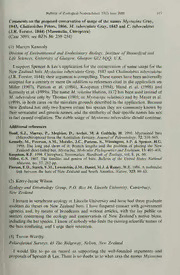
Comments on the proposed conservation of usage of the names Mystacina Gray, 1843, Chalinolobus Peters, 1866, M. tuberculata Gray, 1843 and C. tuberculatus (J.R. Forster, 1844) (Mammalia, Chiroptera) (Case 3095; see BZN 56: 250-254) PDF
Preview Comments on the proposed conservation of usage of the names Mystacina Gray, 1843, Chalinolobus Peters, 1866, M. tuberculata Gray, 1843 and C. tuberculatus (J.R. Forster, 1844) (Mammalia, Chiroptera) (Case 3095; see BZN 56: 250-254)
BulletinofZoological Nomenclature 57(2)June2000 117 Comments on the proposed conservation ofusage ofthe names Mystacina Gray, 1843, Chalinolobus Peters, 1866, M. tuberculata Gray, 1843 and C. tuberculatus (J.R. Forster, 1844) (Mammalia, Chiroptera) (Case 3095; see BZN 56: 250-254) (1) Martyn Kennedy Division ofEnvironmentalandEvolutionary Biology. Institute ofBiomedicaland Life Sciences. University ofGlasgow, Glasgow G12 8QQ. U.K. I support Spencer & Lee's application for the conservation ofname usage for the New Zealand bats Mystacina tuberculata Gray. 1843 and Chalinolobus tuberculatus (J.R. Forster. 1844);theirargumentiscompelling.Thesenameshavebeen universally accepted for a century or more (in addition to references cited in the application see Miller (1907), Pierson et al. (1986), Koopman (1994), Hand et al. (1998) and Kennedyet al. (1999)). The name M. velutina Hutton, 1872 has been used instead of M. tuberculata only by Thomas (1905; as Mystacops velutinia) and by Mayer et al. (1999), in both cases on the mistaken grounds described in the application. Because New Zealand has only two known extant bat species they are commonly known by theirvernacularandgenericnames, and thesimilarity oftheirspecificnameshasnot in factcausedconfusion. ThestableusageofMystacina tuberculatashouldcontinue. Additional references Hand, S.J., Murray, P., Megirian, D., Archer, M. & Godthelp, H. 1998. Mystacinid bats (Microchiroptera) from the Australian Tertiary. JournalofPaleontology. 11: 538-545. Kennedy, M., Paterson, A.M., Morales, J.C., Parsons, S., Winnington, A.P. & Spencer, H.G. 1999. The long and short of it: Branch lengths and the problem of placing the New Zealandshort-tailedbat. Mystacina. MolecularPhylogeneticsandEvolution. 13: 405^16. Koopman, K.F. 1994. Chiroptera: Systematics. Handbook ofZoology, vol. 8, pt. 60. Miller, G.S. 1907. The families and genera of bats. Bulletin ofthe United States National Museum, no. 57. 282 pp. Pierson,E.D.,Sarich,V.M.,Lotvenstein,J.M.,Daniel,M.J.&Ralney,W.E. 1986.Amolecular link between the bats ofNew Zealand and South America. Nature, 323: 60-63. (2) Kerry-Jayne Wilson Ecology andEntonwlogy Group. P.O. Box 84. Lincoln University, Canterbury, New Zealand I lecture in vertebrate ecology at Lincoln University and have had three graduate students do theses on New Zealand bats. I have frequent contact with government agencies and, by means of broadcasts and written articles, with the lay public on matters concerning the ecology and conservation of New Zealand's native biota, includingthe batspecies. I knowofnobodywho findstheexistingscientificnamesof the bats confusing, and I urge their retention. (3) Trevor Worthy Palaeofaunal Surveys, 43 The Ridgeway, Nelson, New Zealand I would like to go on record as supporting the well-founded arguments and proposals ofSpencer& Lee. Thereis nodoubtas to what taxa the names Mystacina 118 BulletinofZoological Nomenclature 57(3)June2000 tuherctdata and Clwlinolohiis luhercukitus refer to, and to change either of them would create confusion. (4) Adrian Paterson Ecology andEntomology Group, P.O. Box 84, Lincoln University, Canterbury, New Zealand I use the name Mystacina tuberculata Gray, 1843 frequently, in teaching, research and publications. This bat is subject to a great deal ofresearch in New Zealand due to its uniqueness and high conservation needs, and its scientific name is in constant usage. I strongly support the application. (5) Peter D. Dwyer Anthropology Program, Department ofGeography andEnvironmentalStudies, University ofMelbourne, Victoria, Australia 3010 I agree with the proposals to preserve the universal usage ofthe names Mystacina tuberculataGray, 1843 and Chalinolobustuberculatus(J.R. Forster, 1844). Spencer& Lee's discussion and recommendations reach beyond, but concur with, my own conclusions (Dwyer, 1960, pp. 10-12; 1962, pp. 2-3). Mutton's (1872) specific name velutinawasanunnecessaryreplacementname forGray's Mystacinatuberculata, and apart from Thomas (1905) and Mayer et al. (1999) has been used by nobody. I support Spencer & Lee's application in the interests ofnomenclatural stability. Additional references Dwyer, P.D. 1960. Studies on New Zealand Chiroptera. Unpublished M.Sc. thesis, Victoria University ofWellington, New Zealand. Dwyer, P.D. 1962. Studies on the two NewZealand bats. Zoology Publicationsfrom Victoria Universityof Wellington, 28: 1-28. Comments on the proposed conservation ofHolochilus Brandt, 1835, Proechimys J.A. Allen, 1899 and Trinomys Thomas, 1921 (Mammalia, Rodentia) by the designation ofH. sciureus Wagner, 1842 as the type species ofHolochilus (Case 3121; see BZN 56: 255-261) (1) Ulyses F.J. Pardiiias Departamento Cientifico Paleonlologia Vertebrados, Museo de La Plata. Pasco del Bosque sin, 1900 La Plata, Argentina After a careful study of the application I completely agree with the proposal to conserve the names Holochilus Brandt, 1835, Proechimys J.A. Allen, 1899 and Trinomys Thomas, 1921 for three genera ofNeotropical rodents. Myconcernsliewith Holochilusas 1 haveworkedwithsigmodontines, particularly fossils but extant as well, for the last 10 years. This genus has a rich fossil record in southern South America, ranging from Middle Pleistocene to Holocene (see Pardiiias, 1999). The first citations (as Holochilus multannus Ameghino, 1889 and
